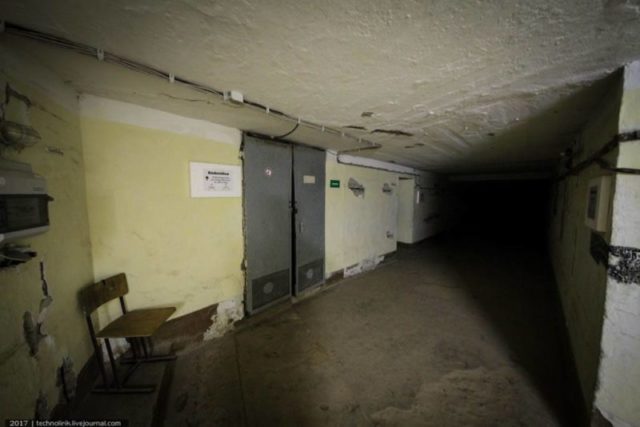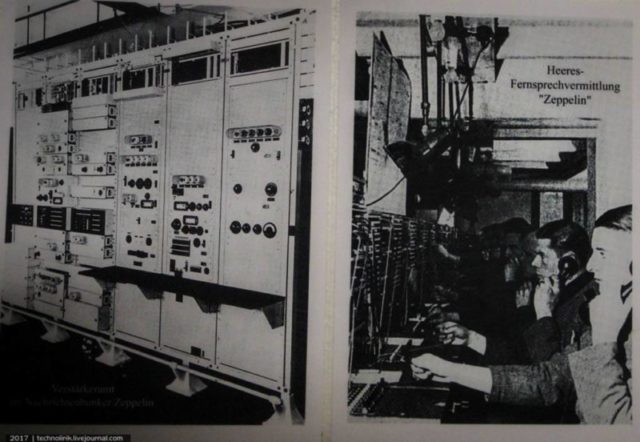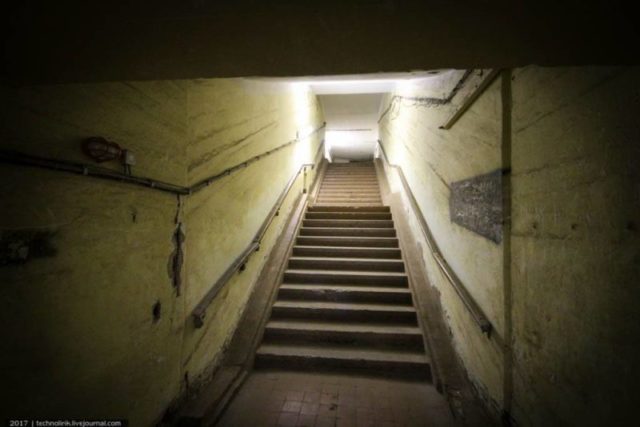Zeppelin is arguably the key facility in Wünsdorf, also known as Bunker Town. It was the main communication center of Nazi Germany, ensuring connection between the Supreme Command of the Wehrmacht as well as the High Command of the Army with battlefronts of the Second World War, as well as communication links between important government offices.
The construction of the bunker began in 1937. Its was officially named AMT-500, code name Zeppelin. The bunker was planned to be connected with Maybach I and Maybach II bunkers, where the Supreme Command of the Wehrmacht was to be stationed (the High Command of the Army also moved here during WWII).
The AMT-500 facility was assigned the role of the main communications bunker of the Third Reich. It was to provide a communication links between the Supreme Command of the Wehrmacht and the future theaters of war, for which Germany was actively preparing.

Initially, two bunkers – AMT-500 (code name Zeppelin) and AMT-5001 (code name Hector) were supposed to be built, but the German industry could not supply the necessary materials and resources to construct both bunkers in time, so plans were adjusted and the idea of AMT-501 abandoned.
The construction of the bunker was assigned to Polensky & Zöllner, one of the largest European civil engineering and construction companies of the day. Approximately 2000 people were working at the site and 60,000 cubic meters of concrete were used.
The bunker had several subterranean galleries leading outside, one of which connected the bunker to the nearby Maybach 1 facility, which housed the High Command of the Army.
There were three entrances to Zeppelin, two of them located at the ends of the northern and southern galleries, while the main entrance was directly above the bunker. It was fitted with a cargo elevator capable of carrying light trucks into the bunker.


The AMT-500 bunker was one of the most fortified underground structures of the Third Reich. A special layered lining was placed between the bunker and ground surface in order to reduce the impact of an explosion. First, just below the ground surface was a 2-meter layer of sand, which was especially effective at dissipating the shock wave.
Then followed a meter of a special material called Zerschellschicht which made aerial bombs explode before they reach the concrete ceiling of the bunker. Below this, another layer of sand, this time 2.5 meters thick, was placed. Finally there was the 3 meters thick concrete roof of the bunker.
Due to its robust design, no type of aerial bombardment was capable of inducing damage to the bunker. In fact, its reserve strength was so great that the bunker could survive a nuclear explosion in the immediate vicinity of the object, although it is yet unknown whether it was designed with that in mind.
Whatever the answer may be, it is still clear as day that the Nazis really made sure their main communications facility would remain operational under any circumstances.
The entrances to the bunker were disguised as ordinary village houses with sloping roofs. These were located at a distance from the bunker, and connected to it by underground passageways. What appeared to be ordinary houses actually had a reinforced concrete core with elevators and staircases to the underground facility.


Inside the bunker there was everything necessary for autonomous operation: backup diesel generators, a filter-ventilation unit, a kitchen, shower rooms and other facilities.
The working conditions at the facility were not easy. Packed with equipment which produced a huge amount of heat, the bunker was hot and stuffy. The cooling system could not cope and allegedly air temperature could reach up to 100 degrees Fahrenheit.
The bunker began operation on May 24, 1939. First it was functioning in test mode, and in August of the same year it moved into the active phase. From here, the chief command was connected with combat units on the eastern front during the operation to attack Poland.
Subsequently, until April 20, 1945, the Zeppelin bunker was the most important node in the communication system of the Wehrmacht, being also the most technologically advanced communications center in the world.


On April 20, 1945, the Germans hurriedly left Wünsdorf. The next day Soviet troops entered the town without a fight, and took over the bunker complexes, including Zeppelin. The bunker was left intact with all the equipment still operational. The bunker was now inside territory occupied by Soviet forces, which later became Eastern Germany.
After the war, the equipment from all Wünsdorf military facilities was dismantled and sent to the Soviet Union as reparations. The dismantling of equipment from Zeppelin alone lasted for weeks and was carried out by local residents, including teenagers, under the supervision of the Soviet military.
Due to the equipment’s fragility and Soviet non-compliance with transportation conditions, most of it broke along the way, arriving in the USSR as fancy scrap metal.
After the official dismantling of equipment, local residents continued to illegally remove anything of value that was left behind. Even though the facility was controlled by Soviet troops, locals exchanged vodka and cigarettes for permission to enter inside the facility to dismantle the remaining equipment.

In 1946 the facility was rigged with explosives and blown up, in accordance with the Potsdam Agreement to demilitarize Germany. The entrances to Zeppelin were blocked off. The bunker was damaged in several places and was partially flooded by groundwater.
A new chapter in the life of the bunker began in the early 1960s, when the Soviet military leadership decided to restore Zeppelin and make it the main communications center of the GSFG (Group of Soviet Forces in Germany). It was now called Ranet.
All entrances to the bunker was fitted with powerful anti-nuclear hermetic locks, and the large halls of the former Zeppelin were divided into smaller rooms.

The Ranet bunker was closely integrated with the communications system of the GDR National Army and also with the main communications bunker of the GDR National Defense Ministry. The facility functioned until the end of 1992, after which the dismantling of equipment and its export to Russia began. In 1994, Russian troops completely withdrew from Wünsdorf.
The bunker was abandoned for a long time. Eventually, enthusiasts decided to revive it, and it was opened to the general public. Today, it is the main tourist attraction of Wünsdorf. You can take an excursion to visit this relic of both the Third Reich and the Eastern Bloc.
A big thank you to technolirik for information and photographs! technolirik


The main structures at the main entrance are part of the original Zeppelin. On the right is a ventilation shaft. The pointy cone-shaped roof was designed for greater resistance to aerial bombardment. In the background are the remains of a former entrance to the facility, which used to be camouflaged as a village house. There was the entrance for trucks to arrive and the cargo elevator.


Next is a system of lock-chambers designed for for disinfection of people entering from the surface during combat operations with the use of atomic or chemical weapons.




After the lock-chamber system is the main structure of the main entrance, which has been preserved since the time of the Wehrmacht. It was here that the cargo elevator was located. In Soviet times, much has been rebuilt, so the layout of this sector is not as it was during the times of the Third Reich.































